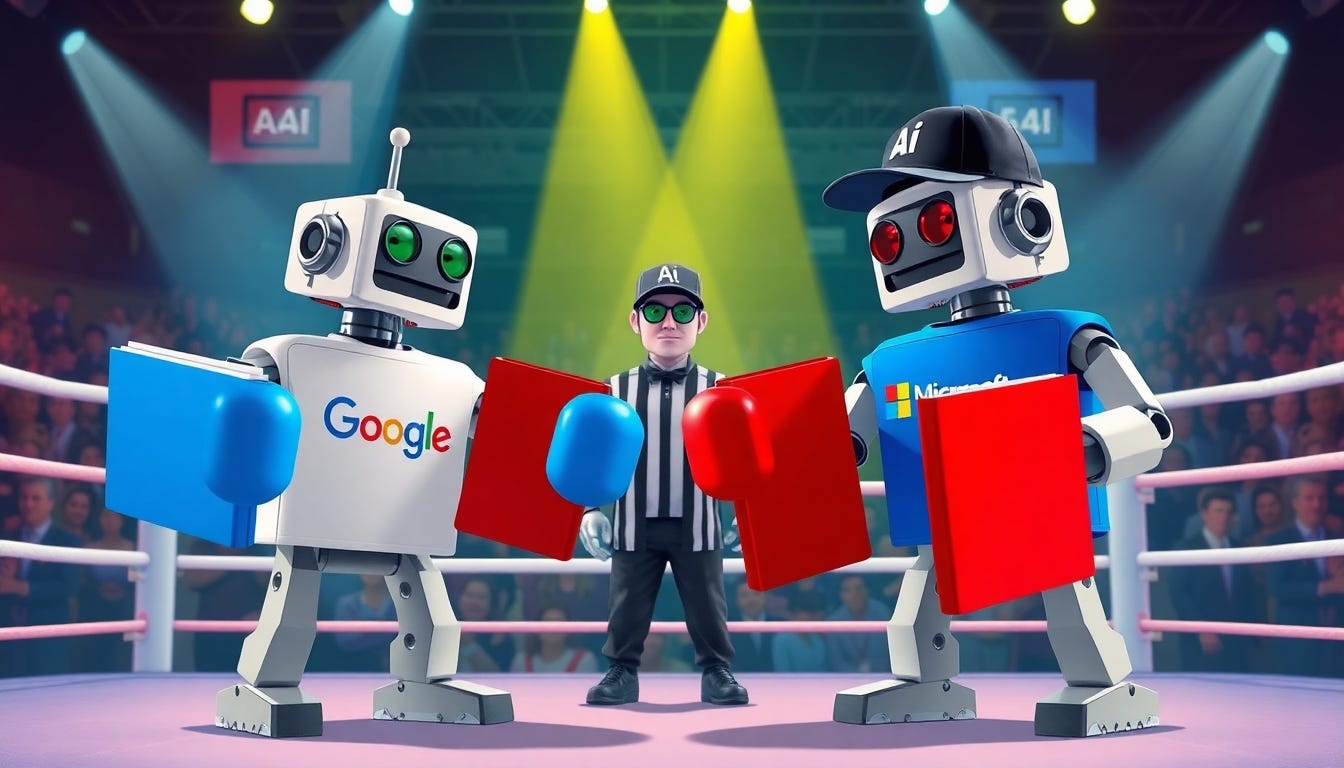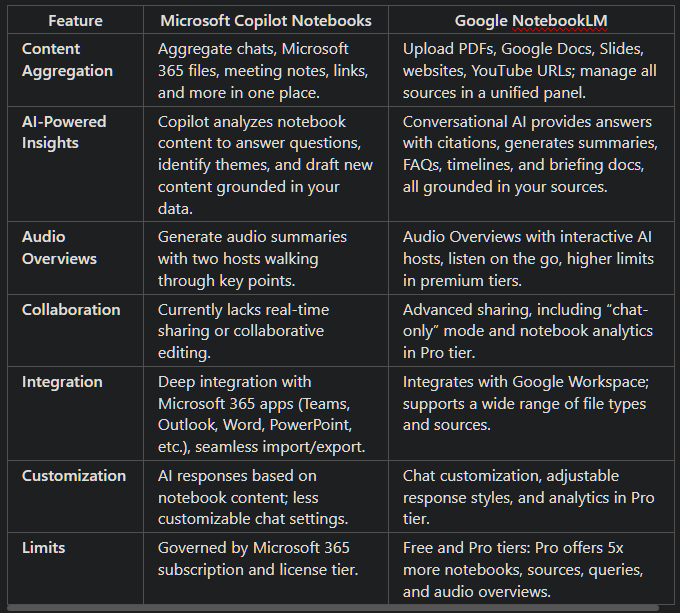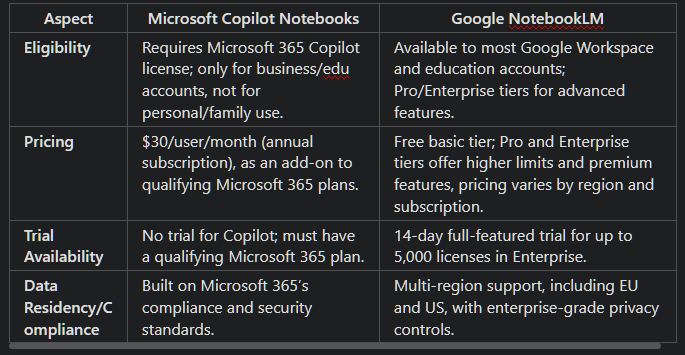I threw up a quick post about vibe writing a couple of months ago that did not go viral (similar to my other work). For that session I bounced between the free version of Perplexity.ai, Microsoft Copilot, and Google’s NotebookLM (both with a business license provided by my employer). It was very productive, with the results easily stored in NotebookLM for later reference.
Last week, I noticed a Notebook feature added to the Copilot screen and thought I would give it a whirl.
The two products have a lot in common. You can load sources to the notebooks, you can chat with the GenAI to analyze or reference the content, and they will both generate an audio summary formatted like a podcast. In that last part, NotebookLM has a maturity advantage both in how long the offering has been available and the capability to control the output.
Both provide easy access to their associated cloud storage. Again, NotebookLM shows the advantage of experience, having incorporated web search discovery for external references.
Copilot Notebook is part of the full Copilot suite of functionality, making it easier to incorporate AI work done earlier and shared functionality within your organization, where Google has its regular menu which is a lesser UX IMHO.
The AI space has a lot in common with New England weather. If you don’t like how it is right now, just wait a bit, it will change fairly soon. I’m pretty sure the Copilot Notebook UI changed just in the week from when I discovered it and today, but I can’t say for sure. Today, if I have my choice (and I do), I would go with NotebookLM for research where I don’t need any sensitive files from Microsoft Office as input, and Copilot Notebook for things where keeping the secret sauce secret is important. That is very much predicated on Office 365 being the collaborative standard in my organization, so YMMV if you don’t.
Not to leave the third participant of my original vibe writing post out, I acquired a Perplexity Pro license since that earlier post and have begun to use their Spaces functionality to have contexts similar to the Notebook offerings. It doesn’t have an audio summary option that I’m aware of, but otherwise I like how it will incorporate references from the internet with attributions for verification. It’s my personal pro account, so I don’t load any work files into it. I do find it useful writing and research. While it does not hallucinate, it is limited to the majority of what is posted online (unless I have time to prompt it along). I originally wanted to have it write the majority of this post, but the content it came back with was not entirely accurate in the areas of capabilities, so I wrote the first part the old fashioned way.
I’m including the final draft that Perplexity came up with, as it has some good info that bears sharing, but doesn’t bear retyping to claim it as my own. Any discrepancies between what I have already written and the following, my opinions and observations are contained in the former.
©2025 Scott S. Nelson
Originally published at https://theitsolutionist.com/2025/06/30/organize-ai-augmentation-with-notebooks/
The following was generated through Perplexity.ai https://www.perplexity.ai/search/write-a-blog-post-comparing-th-vFPgvN4XTc6dxuCt4X_pyQ?2=t#1
Microsoft Copilot Notebooks vs Google NotebookLM
Both platforms promise to make knowledge work more efficient, but their philosophies and user experiences diverge in meaningful ways. Microsoft Copilot Notebooks leverages the deep integration and security of the Microsoft 365 ecosystem, offering a persistent, project-based workspace where AI is grounded in your organization’s documents and conversations. Google NotebookLM, by contrast, is built for flexibility and collaboration, allowing users to aggregate a wide variety of sources, query them conversationally, and generate structured outputs like summaries and study guides.
The stakes for choosing the right tool are high: the right architecture can amplify an organization’s collective intelligence, streamline workflows, and unlock new levels of productivity. Below, I explore how each platform approaches the core challenges of knowledge work—aggregation, synthesis, collaboration, and control—before distilling the comparison into focused tables for quick reference.
The Modern Knowledge Workspace: Context and Control
Microsoft Copilot Notebooks is designed for those who want a unified, persistent workspace where every piece of project context—chats, files, meeting notes, and links—lives alongside AI-powered analysis. The AI here is not a generic assistant; it is tightly constrained to the content you provide, ensuring that responses are both relevant and secure. This approach is a natural extension of Microsoft’s enterprise-first philosophy, emphasizing compliance, data privacy, and seamless integration with tools like Teams, Outlook, and SharePoint.
Google NotebookLM, meanwhile, takes a more open-ended approach. Users can upload PDFs, Google Docs, Slides, and even web content or YouTube URLs, then interact with the AI in a conversational manner. The platform excels at generating structured outputs—summaries, FAQs, timelines—grounded in the uploaded sources, with every answer backed by citations. Collaboration is a first-class feature, with advanced sharing controls and analytics available for power users.
AI as a Creative and Analytical Partner
Both platforms position AI as more than a search tool: it’s a creative and analytical partner. In Copilot Notebooks, the AI can identify themes, answer questions, and draft new content, all within the boundaries of your project’s data. NotebookLM, on the other hand, is optimized for rapid synthesis across disparate formats, making it ideal for research-heavy workflows or teams that need to generate insights from a broad array of materials.
The distinction is subtle but important: Copilot Notebooks is about depth—drilling into your organization’s knowledge base—while NotebookLM is about breadth—pulling together insights from a wide range of sources.
Licensing and Ecosystem Considerations
Choosing between these platforms is not just about features; it’s about fit. Copilot Notebooks is available only as part of a Microsoft 365 Copilot license, targeting organizations already invested in the Microsoft stack. NotebookLM offers a more accessible entry point, with free and paid tiers, and is available to most Google Workspace users. Both offer enterprise-grade privacy, but their licensing models reflect their intended audiences and integration philosophies.
Feature Comparison
License Model Comparison
Perplexity Sources:
https://www.perplexity.ai/page/writing-your-first-book-with-a-BhWJ_y.MS6KRYuSp00k5ag
https://originality.ai/blog/perplexity-and-burstiness-in-writing
https://www.geeky-gadgets.com/using-perplexity-ai-the-writing/
https://www.allaboutai.com/ai-how-to/use-perplexity-pages-ai-to-write-articles/
https://community.honeybook.com/all-about-ai-145/ai-prompt-for-copying-writing-style-2042







I've been working a bit more with Copilot Notebook and it is still decent for research or summarizing. When it comes to getting it to create files it is disappointing. It does not actually produce the files, instead providing a link to /mnt/data/<filename>, which is an unreachable location. Perplexity suggested asking for an HTML output, but the HTML requires some many corrections it wasn't worth the effort. When I prompted it to fix the invalid HTML, the response was "Sorry, I wasn't able to respond to that. Is there something else I can help with?"